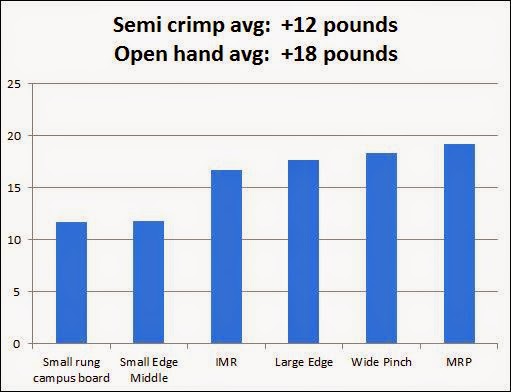The graph above plots my 10 second max weight hangs from the grips listed at right. The y axis reports the amount of weight added to the harness or subtracted via pulleys. The graph shows that extra weight held for 10 seconds increased during the 3 week cycle for all of the grips by some amount between 12 and ~30 pounds, depending on the grip. Two of the grips I added on the 3rd workout (large edge and crisp crimp) and one grip I skipped one week due to lack of access. [Note: during this time period my bodyweight + clothes and harness totalled to about 173 pounds]
Further note: all of these holds are on the Rock Prodigy board, or the standard metolius wood grips campus rung. See image on this post.
The plot is ok, but it leaves me wondering: "Which grips did I gain the most, and on which the least? Is there any logic or pattern to the average amount of gains?"
To answer these questions I calculated the average weight held for the first 6 observations and final 6 observations for each grip, and then calculated the difference between the two. Then I sorted from smallest to greatest.
I omit the "Crisp Crimp" from the next graph simply because I was not actually maxing out performance on that hold. I was gripping that edge with a closed crimp and I was treating it extremely cautiously, so I don't think that the change accurately represent a gain in strength.
On the small campus rung and the small edge I was using the "half crimp" grip or semi-crimp. To try to describe the grip position: the half crimp grip that I use is the pretty standard way of holding a small campus rung, where the pinky and index fingers are open grip, but the middle and ring are only half crimped. The knuckle closest to the finger tip is straight. This allows me to have all four pads on the rung.
The chart is pretty informative, and it raises some interesting questions about how different types of grips are related and how strength gains might be related to both the grips used and the physiology of the athlete.
- Sorting by change in additional pounds held groups the holds according to grip type. The first two (small rung campus board and small edge) are both gripped using a semi open crimp. The next four are all gripped using and open hand grip.
- I gained more strength with the open hand grip than with the closed hand grip
- For every 2 extra pounds in the semi crimp grip I gained 3 pounds in the open hand grip. 50% more progress seems like a big difference (do other people notice a similar difference in their progress?)
- I might just be me. Historically I have been stronger on open hand holds and on moves that emphasize larger holds and endurance.
- Crimps and power on crimps have long been limiting weaknesses
- One interpretation of this chart is that I gain strength in open hand holds faster because those muscles respond more strongly to stimulus than do those involved in crimping.
- An alternative explanation is that I was training more holds (twice as many) that relied on open hand rather than semi crimp grips.
- One final observation involves the pinky finger
- With the exception of the MRP hold, both of the semi crimp holds engage the pinky finger more prominently than do the open hand grips. The pinky is by far the weakest finger.
- It seems possible that a limiting factor of the semi crimp grip is that is loads the pinky more than the open hand grips, and in the semi crimp the two middle fingers are not in the open hand position which has been highly trained in all the open hand hold grips.


No comments:
Post a Comment